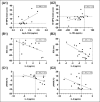Neurophysiological Markers for Monitoring Exercise and Recovery Cycles in Endurance Sports
- PMID: 36157384
- PMCID: PMC9459760
- DOI: 10.52082/jssm.2022.446
Neurophysiological Markers for Monitoring Exercise and Recovery Cycles in Endurance Sports
Abstract
The current study analyzes the suitability and reliability of selected neurophysiological and vegetative nervous system markers as biomarkers for exercise and recovery in endurance sport. Sixty-two healthy men and women, endurance trained and moderately trained, performed two identical acute endurance tests (running trial 1 and running trial 2) followed by a washout period of four weeks. Exercise protocol consisted of an acute running trial lasting 60 minutes. An intensity corresponding to 95% of the heart rate at individual anaerobic threshold for 40 minutes was followed by 20 minutes at 110%. At pre-exercise, post-exercise, three hours post-exercise and 24 hours post-exercise, experimental diagnostics on Brain-derived neurotrophic factor (BDNF), heart rate variability (HRV), Stroop Color and Word Test (SCWT), and Short-Form McGill Pain Questionnaire (SF-MPQ) were performed. Significant changes over time were found for all parameters (p < .05). Furthermore, there was an approached statistical significance in the interaction between gender and training status in BDNF regulation (F(3) = 2.43; p = 0.06), while gender differences were found only for LF/HF-ratio (3hPoEx, F(3) = 3.40; p = 0.002). Regarding the reliability, poor ICC-values (< 0.5) were found for BDNF, Stroop sensitivity and pNN50, while all other parameters showed moderate ICC-values (0.5-0.75). Plasma-BDNF, SCWT performance, pain perception and all HRV parameters are suitable exercise-sensitive markers after an acute endurance exercise. Moreover, pain perception, SCWT reaction time and all HRV parameters show a moderate reliability, others rather poor. In summary, a selected neurophysiological and vegetative marker panel can be used to determine exercise load and recovery in endurance sports, but its repeatability is limited due to its vaguely reliability.
Keywords: NNervous system; biomarkers; executive function; heart rate variability; monitoring training; reliability.
© Journal of Sports Science and Medicine.
Figures





Similar articles
-
[The effect of aerobic and anaerobic endurance training on the regulating function of autonomic nervous system and its significance].Sheng Wu Yi Xue Gong Cheng Xue Za Zhi. 2006 Oct;23(5):1020-3. Sheng Wu Yi Xue Gong Cheng Xue Za Zhi. 2006. PMID: 17121345 Clinical Trial. Chinese.
-
A Submaximal Running Test With Postexercise Cardiac Autonomic and Neuromuscular Function in Monitoring Endurance Training Adaptation.J Strength Cond Res. 2017 Jan;31(1):233-243. doi: 10.1519/JSC.0000000000001458. J Strength Cond Res. 2017. PMID: 27100319
-
Monitoring endurance running performance using cardiac parasympathetic function.Eur J Appl Physiol. 2010 Apr;108(6):1153-67. doi: 10.1007/s00421-009-1317-x. Epub 2009 Dec 22. Eur J Appl Physiol. 2010. PMID: 20033207
-
Heart rate-based indices to detect parasympathetic hyperactivity in functionally overreached athletes. A meta-analysis.Scand J Med Sci Sports. 2021 Jun;31(6):1164-1182. doi: 10.1111/sms.13932. Epub 2021 Mar 4. Scand J Med Sci Sports. 2021. PMID: 33533045
-
Effect of exercise training on heart rate variability in type 2 diabetes mellitus patients: A systematic review and meta-analysis.PLoS One. 2021 May 17;16(5):e0251863. doi: 10.1371/journal.pone.0251863. eCollection 2021. PLoS One. 2021. PMID: 33999947 Free PMC article.
References
-
- Alves C.R., Gualano B., Takao P.P., Avakian P., Fernandes R.M., Morine D., Takito M.Y. (2012) Effects of acute physical exercise on executive functions: a comparison between aerobic and strength exercise. Journal of Sport and Exercise Psychology 34, 539-549. https://doi.org/10.1123/jsep.34.4.539 10.1123/jsep.34.4.539 - DOI - PubMed
-
- Becker M., Sperlich B., Zinner C., Achtzehn S. (2020) Intra-Individual and Seasonal Variation of Selected Biomarkers for Internal Load Monitoring in U-19 Soccer Players. Frontiers Physiology 11, 838. https://doi.org/10.3389/fphys.2020.00838 10.3389/fphys.2020.00838 - DOI - PMC - PubMed
-
- Bellenger C.R., Fuller J.T., Thomson R.L., Davison K., Robertson E.Y., Buckley J.D. (2016) Monitoring Athletic Training Status Through Autonomic Heart Rate Regulation: A Systematic Review and Meta-Analysis. Sports Medicine 46, 1461-1486. https://doi.org/10.1007/s40279-016-0484-2 10.1007/s40279-016-0484-2 - DOI - PubMed
-
- Bernik T.R., Friedman S.G., Ochani M., DiRaimo R., Susarla S., Czura C.J., Tracey K.J. (2002) Cholinergic antiinflammatory pathway inhibition of tumor necrosis factor during ischemia reperfusion. Journal of Vascular Surgery 36, 1231-1236. https://doi.org/10.1067/mva.2002.129643 10.1067/mva.2002.129643 - DOI - PubMed
-
- Boos C.J., Vincent E., Mellor A., O'Hara J., Newman C., Cruttenden R., Scott P., Cooke M., Matu J., Woods D.R. (2017) The Effect of Sex on Heart Rate Variability at High Altitude. Medicine & Science in Sports & Exercise 49, 2562-2569. https://doi.org/10.1249/MSS.0000000000001384 10.1249/MSS.0000000000001384 - DOI - PubMed
MeSH terms
Substances
LinkOut - more resources
Full Text Sources
Research Materials
Miscellaneous
